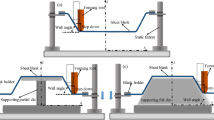Abstract
The forming limit stress curve (FLSC) is often recommended as failure criterion for the virtual tryout of forming processes which include non-proportional loading. However, parameters influencing position and shape of the forming limit stress curve are not fully known. Up to today it has not been proved if the forming limit curve is strain path-independent, or at least approximately path-independent. In this study the influence of the parameters yield criterion, flow curve extrapolation and level of pre-stretching on the applicability of the FLSC as failure criterion are assessed. The work is performed using the aluminum alloy AA6014 based on forming limit curves for proportional and non-proportional loading published in Werber et al. Key Eng Mater 502–506:71–76, (2012). FLSCs are generated for yield criteria according to von Mises and Hill’48, for flow curve extrapolations according to Ghosh and Hockett-Sherby as well as for an experimentally measured flow curve. In order to be able to assess the influence of the described parameters on the failure criterion based on the FLSC the application of a mean forming limit stress curve (MFLSC) is used. This method is based on the assumption that all FLSCs gained for proportional as well as non-proportional loading map to one single curve. The influence of yield criterion and flow curve approximation on the FLSCs is addressed; the strain path dependency of FLSCs is proved and the forming limit curves for non-linear loading calculated with an assumed mean forming limit stress curve are compared to the experimentally gained forming limit curves.















Similar content being viewed by others
References
Arrieux R, Bedrin C, Boivin M (1982) Determination of an intrinsic forming limit stress diagram for isotropic metal sheets. In: Proceedings of the 12th Biennial congress of the IDDRG, pp 61–71
Arrieux R, Boivin M, Le Maitre F (1987) Determination of the forming limit stress curve for anisotropic sheets. Ann CIRP 36:195–198
Banabic D, Bunge H-J, Pöhland K, Tekkaya A, Banabic D (Eds) (2000) Formability of metallic materials. Springer, Berlin
Chen MH, Gao L, Zuo DW, Wang M, (2007) Application of the forming limit stress diagram to forming limit prediction for the multi-step forming of auto panels. J Mater Process 187–188:173–177
Ghosh AK, Laukonis JV (1976) The influence of strain path changes on the formability of steel sheet. In: 9th Biennal congress of the IDDRG, Sheet metal forming and energy conservation. ASM Publication
Ghosh A, (1980) A physically-based constitutive model for metal deformation. Acta Metall 28:1443–1465
Graf AF, Hosford WF (1993). Calculations of forming limit diagrams for changing strain paths. Metall Trans A 24:2497–2501
Graf A, Hosford W (1994) The influence of strain-path changes on forming limit diagrams of Al 6111 T4. Int J Mech Sci 36(10):897–910
Goodwin G (1975) Application of strain analysis to sheet metal forming problems in the press shop. Socity of Automotive Engineers, No.680093, pp 87–98
Hill R (1948) A theory of the yielding and plastic flow of anisotropic metals. Proc R Soc Lond 193:281–297
Hockett J, Sherby O (1975) Large strain deformation of polycrystalline metals at low homologous temperatures. J Mech Phys Solids 23:87–98
DIN EN 10002-1: Metallische Werkstoffe Zugversuch, Teil 1: Prüfverfahren bei Raumtemperatur
International standard ISO 12004 (2), Metallic materials—sheet and strip—determination of forming-limit curves Part 2: determination of forming-limit curves in the laboratory, Reference number ISO 12004-2:2008(E)
Keeler S, Backofen W (1963) Plastic instability and fracture in sheets stretched over rigid punches. ASM Trans 56:25–48
Keller S, Hotz W, Friebe H (2009) Yield curve determination using the bulge test combined with optical measurement, IDDRG international conference
Kleemola HJ, Pelkkikangas MT (1977) Effect of predeformation and strain path on the forming limits of steel, copper and brass. Sheet Metal Ind 63:591–599
Marciniak Z, Kuczynski K, Pokora T (1973) Influence of the plastic properties of a material on the forming limit diagram for sheet metal in tension. Int J Mech Sci Pergamon Press. 15:789–805
Müschenborn W, Sonne H-M (1975) Einflu des Formnderungsweges auf die Grenzformnderungen des Feinblechs. Arch Eisenhttenwes 46(9):597–602
Nurcheshmeh M, Green DE (2011) Investigation on the strain-path dependency of stress-based forming limit curves. Int J Mater Form 4:25–37
Ofenheimer A, Buchmayr B, Kolleck R, Merklein M (2005) Forming limits in sheet metal forming for non-proportional loading conditions—experimental and theoretical approach, Numisheet, A
Stoughton TB (2000) A general forming limit criterion for sheet metal forming. Int J Mech Sci 42:1–27
Stoughton TB (2001) Stress-based forming limits in sheet-metal forming. J Eng Mater Technol 123:417–422
Stoughton TB, Zhu X (2004) Review of theoretical models of the strain-based FLD and their relevance to the stress-based FLD. Int J Plast 20:1463–1486
Stoughton T, Yoon J-W, Liewald M (Eds) (2012) Advances in metal forming limits under nonlinear and out-of-plane forming conditions. New developments in sheet metal forming, pp 221–240
Tong L, Hora P, Reissner J (2002) Prediction of forming limit with nonlinear deformation paths using modified maximum force criterion, Numisheet
Volk W, Suh J (2012) Reliable and robust evaluation of local necking with a generalized thinning limit diagram. In: Proceedings of 5th Forming Technology Forum, Zürich, Switzerland, pp 115–120
Werber A, Liewald M, Nester W, Grünbaum M, Wiegand K, Simon J, Timm J, Bassi C, Hotz W (2012) Influence of different pre-stretching modes on the Forming Limit Diagram of AA 6014. Key Eng Mater 504–506:71–76
Yoshida K, Kuwabara T, Kuroda M (2007) Path-dependence of the forming limit stresses in a sheet metal. Int J Plast 23:361–384
Yoshida K, Kuwabara T (2007) Effect of strain hardening behavior on forming limit stresses of steel tube subjected to nonproportional loading paths. Int J Plast 23:1260–1284
Yoshida K, Suzuki N (2008) Forming limit stresses predicted by the phenomenological plasticity theories with anisotropic work-hardening behavior. Int J Plast 24:118–139
Author information
Authors and Affiliations
Corresponding author
Rights and permissions
About this article
Cite this article
Werber, A., Liewald, M., Nester, W. et al. Assessment of forming limit stress curves as failure criterion for non-proportional forming processes. Prod. Eng. Res. Devel. 7, 213–221 (2013). https://doi.org/10.1007/s11740-013-0446-6
Received:
Accepted:
Published:
Issue Date:
DOI: https://doi.org/10.1007/s11740-013-0446-6



